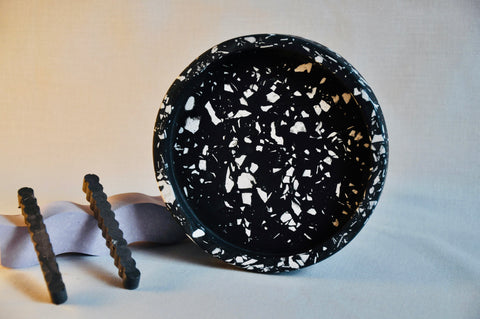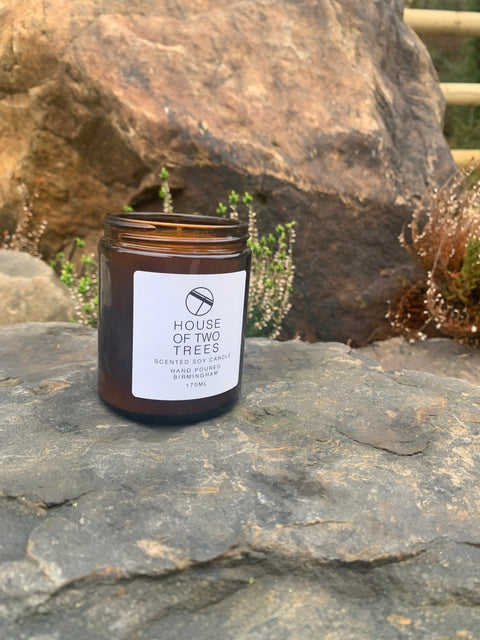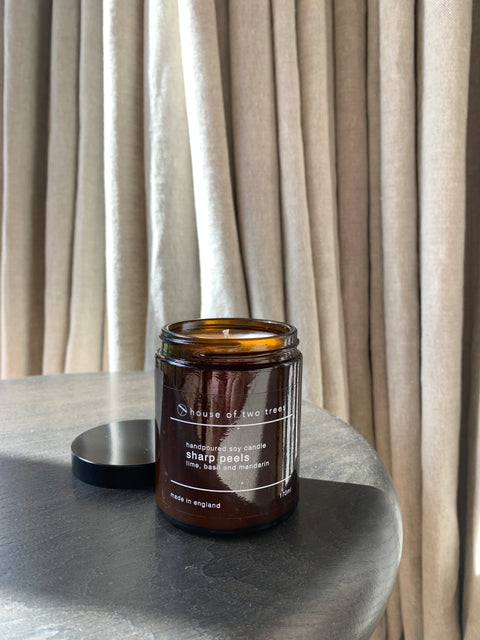
As conscious consumers, we’re becoming more aware of our daily environmental impact – including when it comes to our home décor purchases. Wondering whether the items we buy are sustainable or even good for the environment is slowly becoming a normal part of life.
Jesmonite isn’t exactly a new product on the market (since it was created almost 50 years ago!). But its use in home décor has soared in popularity in recent years, particularly among artists, architects and businesses. This is mostly due to its safe, sustainable and visually stunning qualities.
If you’re thinking about buying a Jesmonite coaster, tray or centrepiece, you may be wondering, “What is Jesmonite?” and, “Is it eco-friendly?”.
If so, we’ll answer all your questions about Jesmonite in this article, including what it is, what products are made from it and whether its production is sustainable long-term.
What is Jesmonite?
Jesmonite is made from a combination of gypsum (a mineral created from sedimentary rock) and water-based acrylic resin.
It was originally created in the UK during an experiment with concrete technology. After many successful tests, it became primarily used in the construction industry, mostly for building high-quality surface materials.
However, in recent years, the substance has become increasingly popular among artists, sustainable businesses and the home crafting community.
This is mostly due to how Jesmonite is considered safe, sustainable and very easy to use, especially when compared with other alternative materials (like fibreglass, polyester, plaster, concrete or resin).
What Can Be Made from Jesmonite?
Jesmonite is extremely versatile and can be used to create almost anything. Since it was created in the 1980s, its use has continuously evolved.
As mentioned, Jesmonite was originally designed for the construction industry to cast and laminate buildings. Later, it grew in popularity among artists for creating sculptures.
With green consumerism on the rise, you’ll now find some businesses creating sustainable home décor products from Jesmonite – like coasters, trays, bowls and centrepieces.
You may even find some companies or architects creating floor tiles, tabletops and even kitchen fixtures (like splashbacks and wall panels) from the substance.
This shift from construction to home décor is an unsurprising move for Jesmonite. Since it can be mixed with different pigments and materials to create numerous textures and designs, it can lead to the production of some very aesthetically pleasing home statement pieces.
What are the Benefits of Making Products With Jesmonite?
Most designers and artists prefer to make products with Jesmonite over other materials (like fibreglass) because of the benefits it brings.
If you’re thinking about making a product from Jesmonite as a home-crafting project, here are just some of the benefits of using the substance:
- Durability – it’s highly malleable and lasts a long time, so you’re unlikely to break it during or after the crafting process
- Flexibility – you can use it to create almost anything and it can mimic textures like stone, metal, wood, leather and even fabric
- Safety – it doesn’t emit toxic fumes when used, nor are there any reported health risks of using it regularly (although safety precautions are still recommended)
- Charm – it’s often considered a natural-looking alternative to plastic that has a luxurious, high-end vibe
- Sustainability – because of how it’s made and what it’s made from, Jesmonite is considered a sustainable material
Plus, working with Jesmonite is easy and it allows for full creative expression. This can make working with the material a highly rewarding and mesmerising experience.
This is perfect for two reasons. For one, when you make something from Jesmonite, you’ll have complete freedom to experiment and design something truly unique.
Secondly, if you choose to buy a handmade Jesmonite coaster or tray, you’ll be buying something one-of-a-kind that you know the creator actually enjoyed making for you!

Is Jesmonite Eco-Friendly?
When considering the question, “Is Jesmonite eco-friendly?”, the short answer is yes! It’s made from a natural material (sedimentary rock) and has a low-energy manufacturing process.
But let’s explore in further detail what Jesmonite is made from, how it’s made and how long it lasts to determine its true sustainability.
Firstly, Jesmonite is primarily made from gypsum, which, as mentioned, comes from sedimentary rock. To create gypsum, it needs to be surface mined, crushed, separated and dried. This process requires little energy and its biggest emission is steam (source).
In addition to this, UK gypsum manufacturers are committed to various eco-friendly initiatives (source). This includes making use of by-products, recycling their materials and using as little packaging as possible.
However, it’s important to note that Jesmonite is also mixed with acrylic during manufacturing, which is plastic.
We all know plastic is bad for the environment – mostly due to its inability to break down. Yet it’s this quality that means Jesmonite products are considered highly durable and long-lasting. So, despite its mixture with some form of plastic, Jesmonite is considered a sustainable product.
When reviewing whether specific Jesmonite products are sustainable, like handmade coasters and trays, it’s important to note that these can (and should) be made without the use of a kiln or oven, as the mixture can set at room temperature. This means that little to no energy is used in the actual manufacturing of these specific handmade products.
What’s the Difference Between Jesmonite AC100 vs AC730?
As the use of Jesmonite has evolved, different types have been introduced to the artistic market. Each variant has subtly different qualities to cater to each creative expression.
If you want to buy Jesmonite, or are simply wondering what the differences are between Jesmonite AC100 vs AC730, here’s a quick summary.
Both Jesmonite AC100 and AC730 are:
- Water-based
- Solvent-free
- Contain no VOCs (Volatile Organic Compounds)
- Fire-resistant
- Impact-resistant
- Easy to sand (by hand or using an electric sander)
In addition to this, Jesmonite AC100:
- Is easy to use
- Is one of the most malleable types of Jesmonite
- Sets quickly in around 50 mins to 2 hours
- Is extremely lightweight (making it ideal for jewellery)
- Can replicate almost any surface, colour and texture when mixed with other materials
With Jesmonite AC730, this type:
- Is durable in all weather conditions (making it perfect for outdoor use, water features, pots and kitchen splashbacks)
- Sets in around 4 hours
- Is designed for small decorative castings or glass-reinforced, lightweight and hand-laminated decorative applications
- Has a reduced free-lime content with low alkalinity (leading to less efflorescence than some other types of Jesmonite)
Conclusion
Overall, Jesmonite is considered a sustainable material. Its source material is natural and it has a low energy manufacturing process. Plus, there are numerous benefits (environmental and other) to choosing a Jesmonite product over another material.
If you’re thinking about purchasing a Jesmonite coaster, centrepiece or tray from House of Two Trees, you can rest assured in knowing that your product has been made with love and care to bring you something truly unique!
Using Jesmonite substances, our handmade collections of coasters, centrepieces and trays are curated with a mix of on-trend colours and contemporary styles.
SHOP NOW to explore our stunning range (and plant a tree with every purchase!).





Comments (0)
There are no comments for this article. Be the first one to leave a message!